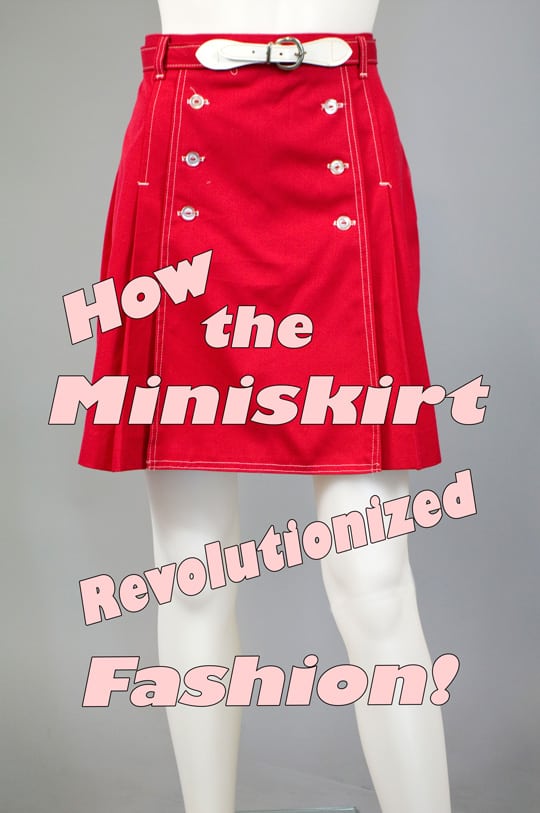
The miniskirt made fashion history for three distinct reasons: It showed more leg on a woman than ever noted in fashion history before, it represented the democratization of fashion as the influential grips of Parisian couture lessened and it helped to fuel a movement for female social and sexual liberation that began in the 1960s.
Defined as a skirt with a hemline averaging halfway up the knee (and falling approximately four inches below the butt!), the miniskirt was popularized by Mary Quant, who introduced her own version of the skirt at her London boutique Bazaar in 1964.
While not its true inventor, we can thank Quant’s boutique for first spreading viral word of the mini (which she amusingly named after her favorite car) to the trendy teens of London’s mod fashion culture whom shopped there.
While these Swingin’ London teens wore the flirtatious styles in rebellion against fashion’s old guard, it was only once designers like André Courrèges, Yves Saint Laurent and Rudi Gernreich introduced their own versions of the miniskirt to the runways that fashion media and the general public began to take notice and want a version of their own, no matter their age.
<< SHOP NOW: Authentic & awesome 1960s vintage clothing
The history of the miniskirt is worth more than just a shorter hemline. The mini is perhaps the most revolutionary of styles because it surpassed the idea of “trend” and has proven itself worthy of another “T” category … that of timeless.
1960s Style Dresses from Shabby Apple
As you’ll see illustrated by vintage advertisements and magazine spreads in this article, the miniskirt isn’t just marvelous for its fashion function, but for its fashion revolution.
Because the trend is so timeless for today there’s no reason you can’t grab a marvelous vintage mini for yourself and own a piece of fashion history. Consider the changes to come as the New Millennium progresses. Perhaps the mini will be but a piece of 1960s fashion’s past come 2050!
I’ve enjoyed receiving positive and constructive feedback on these history-focused posts. Please don’t hesitate to note a key point I missed or call out a factual error for correction by leaving a comment below.
Please say hello on Twitter, Facebook, Instagram or by subscribing to my newsletter!
xx, SD
The Miniskirt Revolution
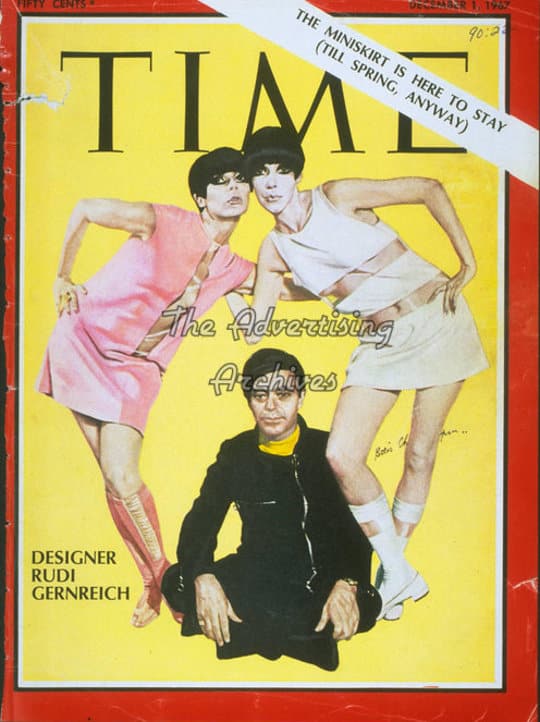
Source: Image Courtesy of The Advertising Archives
The miniskirt could have been just another fleeting fad, like the highly remembered but short-lived poodle skirts of 1950s fashion or an Elsa Schiaparelli ice cream cone hat of 1930s fashion.
The miniskirt became a mainstay because while adopted first by teenagers, the influence of culture’s “youthquake” influenced what high fashion designers felt was most desirable by the masses. Like an artist turns to his muse, designers turned to street fashion for an understanding of what the people truly wanted and ultimately, what would sell.
When American designer Rudi Gernreich introduced his own version of the miniskirt in his late ’60s fashion collections, the revolution of the less-is-more skirt trend already had a permanent place overseas in the states.
But because Gernreich endorsed the look with his runway designs, the style was adopted beyond just leggy, pubescent 15 to 20 year olds.
Mary Quant: Mother of the Miniskirt
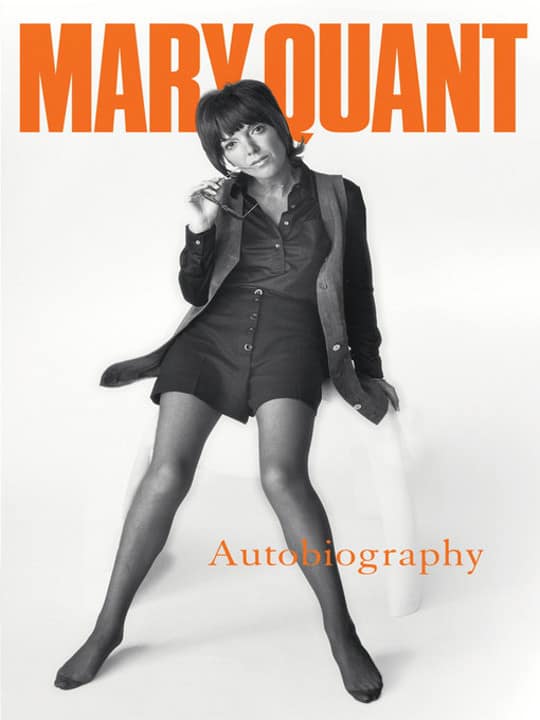
Source: Mary Quant Autobiography on Amazon
Mary Quant is identified as the inventor of the miniskirt, but the truth is that while she was one of its first public proponents she is not its true inventor.
In fact, some argue that the miniskirt wasn’t born in the ’60s at all! Evidence exists showing Egyptian women wearing leg-baring styles, leading academic scholars to believe that the mini was a fashion element of civilization as early as 4700 BC.
But fast forward to the ’60s, and we needed a woman to pioneer the trend out of the caves and onto the streets, and that woman was Mary Quant, “the mother” of the mini.
Quant’s trendy London boutique Bazaar first opened in 1955 for the every woman to shop high-quality, affordable garments. Quant didn’t believe snobbery was stylish, so her store was one of the first where the neighborhood’s young artists and hipster socialites felt they could shop and be themselves.
Quant is quoted as saying about Bazaar, “‘Snobbery has gone out of fashion, and in our shops you will find duchesses jostling with typists to buy the same dresses.”
When Quant began carrying her own designs of a shockingly short skirt — which she named “mini” after her favorite car — in 1964, her open minded clients snatched them up as a statement against their parents, society and everything their liberated, self-expressive fashion sense stood for.
John Bates and Andre Courrèges: Fathers of the Miniskirts
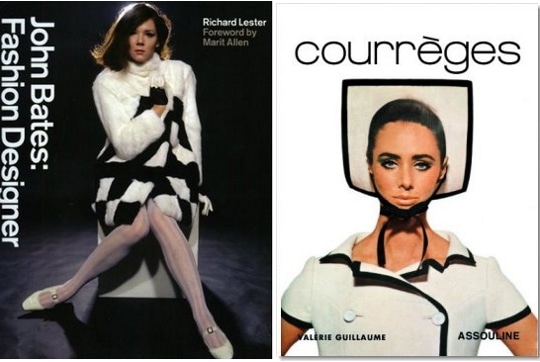
Source: John Bates: Fashion Designer Book & Courreges Book on Amazon
While Mary Quant is often credited as the inventor of the miniskirt, both André Courrèges and John Bates (designer of label Jean Varon) can be thanked for the revolution of the rising hemline.
John Bates began designing in 1959, pushing the envelope with unconventionally sexy styles as worn by Diana Rigg on ’60s television class The Avengers. His experimentation with shorter hemlines, exposing the midriff and bralessness (gasp!) began in the early ’60s and according to the most in touch of fashion media like Ernestine Carter, the fashion editor of London’s Sunday Times, it is Bates who should be credited with developing the style of the short skirt, which would later be dubbed “the mini” by Mary Quant.
But it was also French designer André Courrèges who introduced the idea of the mini to the world with his above-the-knee futuristic Space Age styles from his “Moon Girl” collection in 1964, the same year Quant did to London’s trendy youth at Bazaar boutique.
Perhaps because of mutual influence Courrèges and Quant should be awarded a tie for the trend, but in my opinion it was truly as Quant most famously put it, “It wasn’t me or Courrèges who invented the miniskirt anyway—it was the girls in the street who did it.”
Miniskirt Female Empowerment
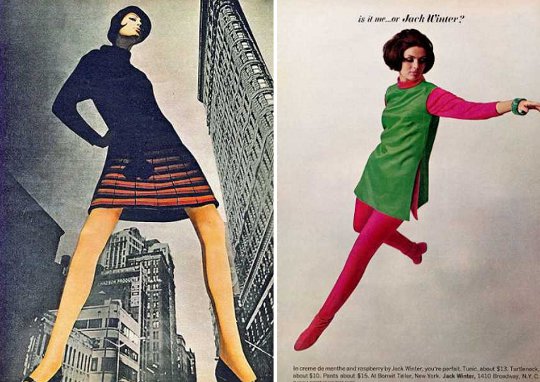
Source: Vintage Ad Browser
The miniskirt’s growing popularity paralleled the growing power of the women’s rights movement in the 1960s.
A young lady’s style of the early 1960s was sweet and demure, still marked by notes of 1950s trends like circle skirts, cinched waists and gasp-worthy girdles. But by the latter half of the ’60s, a girl wore her skirts and dresses in an expressive and exciting way that represented her active lifestyle, marked by bright colors of colorblocks, geometric lines and psychedelic prints.
The Feminine Mystique was published in 1963, inspiring women to define their own professional roles and to gain income equivalent to that of their male co-workers. Combined with the sexual revolution behind the invention of the birth control bill and the organization of NOW in 1966 (National Organization for Women), the miniskirt’s introduction represented a woman’s ownership of not just her legs, but her life.
Note how the advertisement on the left depicts a miniskirt wearing woman to stand as tall as sky high buildings, as if she were a glamazon slamming her feet onto the streets and metaphorically speaking, taking giant leaps as her masculine-matching role in society grew.
Miniskirt of the Youthquake
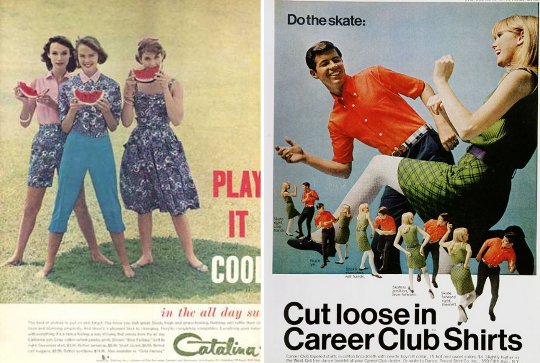
Source: Vintage Ad Browser
Youth styles of the early ’60s were dramatically different when compared to that of the mid and later ’60s.
The vintage advertisement on the left is from 1960 and shows sweet girls innocently eating watermelon while wearing floral prints. But compared to another ad depicting teens in 1967, and we see young girls wearing mini skirts and tights while doing “The Skate” up close and personal with their beau — not hanging out with the girls eating a melon!
Before the mid ’60s, teens would shop with their parents, who purchased them junior styles designed as less sophisticated versions of what they wore at home or to their jobs.
But these weren’t the unconventional, exciting styles teens yearned for. With money in their pockets and mass media like television and magazines influencing their craving for generational divide, the teens of London flocked to boutiques (Mary Quant’s Bazaar) because they were the only places welcoming of “their culture.”
Boutiques became a place to be seen, staying open late so that customers could hang out and then leave with the owners and employees to seize the night. The miniskirt was so embraced by young women because like the lives they craved, the styles were without structure and restriction. You could move freely in a mini!
Youthquake fashion was of energy, vitality and movement, and the miniskirt found itself on top of this new fashion focus. (Research Source: Interview, On Pins & Needles)
Mother-Daughter Dressing Evolves
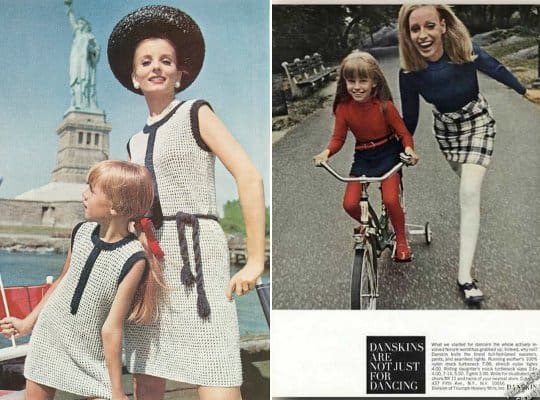
Source: Cemetarian / Vintage Ad Browser
The mother daughter trend of dressing similarly suffered a serious blow when the miniskirt was introduced, since older women couldn’t pull off the style in quite the same way as their teen daughters.
The youth of the ’60s then gained power from their parents, because they were connected to an entirely different way of dressing, thinking and behaving. The “teen” culture of the ’60s was almost frightening to their parents because the control they had as a family core was broken down by the teenager’s distraction of things beyond their namesake.
However, as the miniskirt trend infiltrated high fashion so did it enter the wardrobes of women older than 25, but in a much more understated, practical way. Young moms comfortable with wearing the rising hemline wore skirts and dresses at lengths like their daughters, as these two vintage advertisements depict.
The 1960s Lolita Look
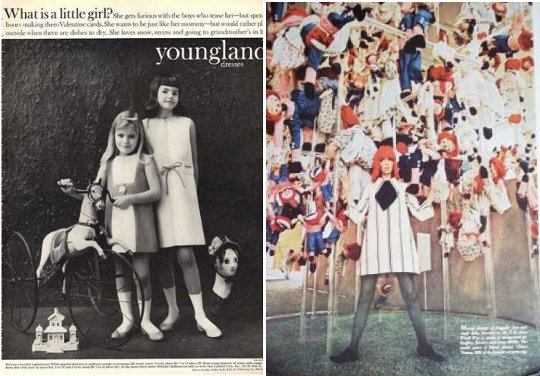
Source: Vintage Ad Browser
The miniskirt trend ushered in a new kind of dressing that was dubbed the Lolita look because it resembled the styles a child would wear. Almost like Never Never Land for fashion, a girl was expected to dress like a girl — not a woman.
Cross examine these two ’60s advertisements and you’ll see the uncanny resemblance of styles between literal pubescent girls (the left) and a model styled to simply look like one, down to her Raggedy Ann hair as if she were a child’s doll.
Since above-the-knee styles were typically worn by little girls prior to the miniskirt trend, it makes sense that teenagers like Twiggy rised to the top of ’60s era model stardom. With the styles marketed to their yet-to-blossom bodies, teenage girls became the face of high fashion editorial for the first time.
Miniskirts in Magazines
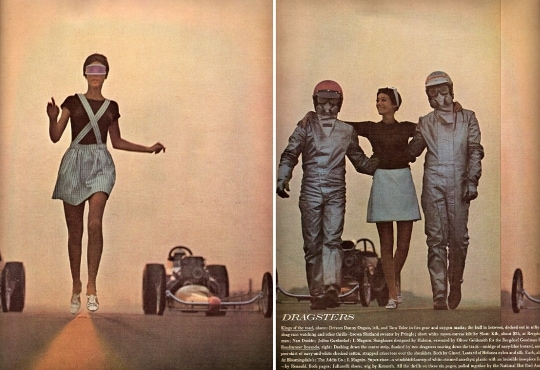
DRAGSTERs Editorial from April 1967 edition of Vogue Magazine – Photographer de Rosnay & Modern Marisa Berenson / Sourced from The Fashion Spot Forums
While the miniskirt trend literally started on the streets of London’s Kings Road (the trendy boutique district where Mary Quant’s Bazaar was located), it wouldn’t take long for the trend to hit the pages of glossy magazines.
Once high fashion designers like André Courrèges and Rudi Gernreich began releasing their own versions of the mini to the runways of haute couture, magazines like Vogue took notice and promoted department store styles to their sophisticated readership, like this editorial “Dragsters” depicts with its play on the fast speed of shorter styles.
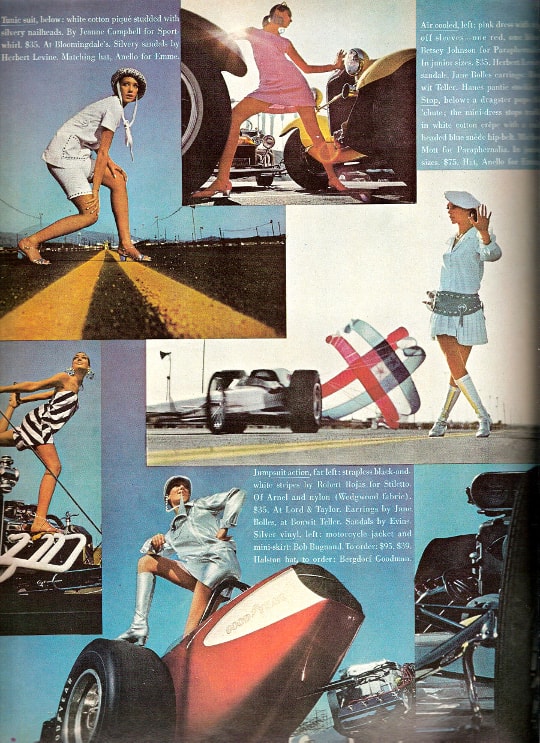
DRAGSTERs Editorial from April 1967 edition of Vogue Magazine – Photographer de Rosnay & Modern Marisa Berenson / Sourced from The Fashion Spot Forums
Minis Worn in a Modern Way

Today the miniskirt (as well as mini dresses, like the one from Vintage a Go-Go I’m wearing above!) is worn by millions of girls without so much as the blink of an eye.
While people have their opinions as to how short a mini should go, the culture of the 21st century Western Society remains one of consideration of environment before wearing. A miniskirt worn to court is totally inappropriate to even the most liberal of judges, but the same style worn to the office of a graphic designer may pass over just fine.
With individuality at its peak, it’s hard to say what the hard-fast rules are to dressing well, and to dressing “right.”
However, as recent as March 2012 public officials in Indonesia called for miniskirts to be outlawed from public wear because of “what they make men do.”
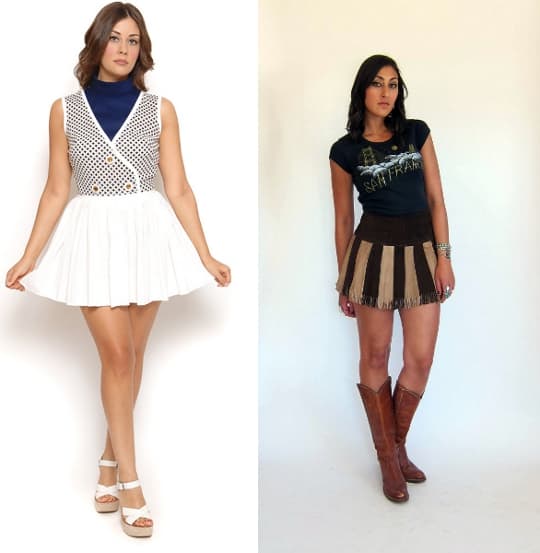
Buy it Vintage: 1960s White Mini Skirt Dress, $48 / 1960s Brown Suede Fringed Mini Skirt, $50
So unless you’re unfortunate enough to live in Indonesia (and don’t even get me started on that), the miniskirt is perhaps the oldest vintage trend worn by the modern woman today.
With such a broad range of 1960s mini skirt styles available to buy from Etsy, why not buy a vintage mini skirt from the ’60s instead of a modern one?
You’ll not only own something uniquely different from anything you can find in stores now, but you can preserve it for a future of fashion lovers who will look back at the ’60s in even greater awe than we do today.
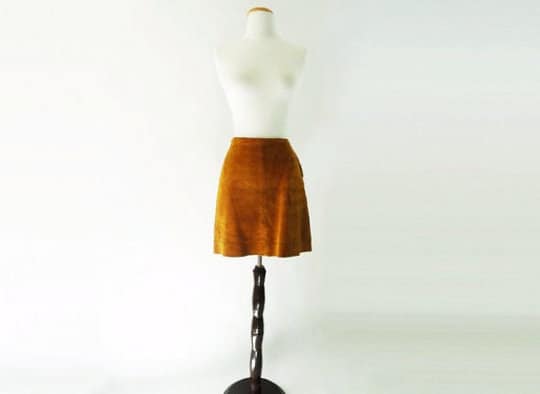
Buy it Vintage: 1960s Marigold Suede Mini Skirt, $56
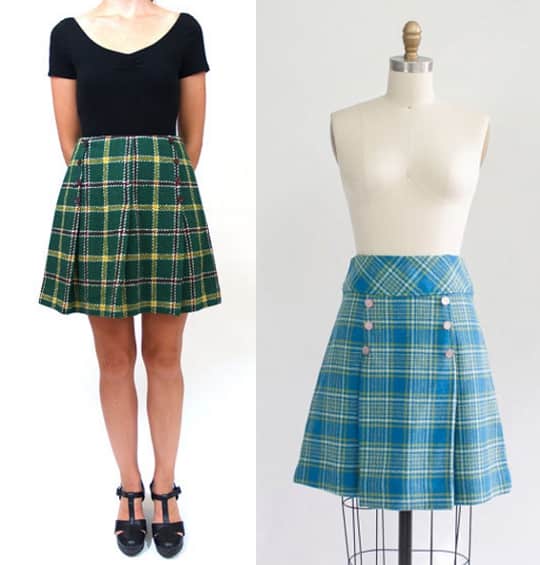
Buy it Vintage: 1960s Schoolgirl Plaid Mini Skirt, $24 / 1960s Schoolgirl Plaid Mini Skirt, $34
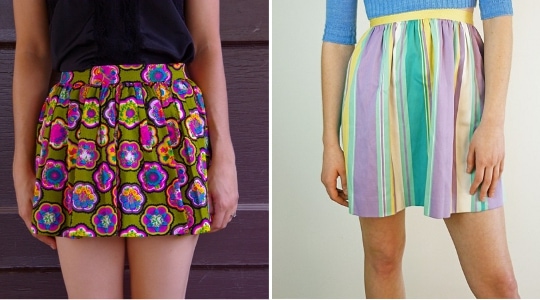
Buy it Vintage: 1960s Psychedelic Mini Skirt, $46 / 1960s Striped Mini Skirt, $26
What’s your take on the miniskirt? Will it remain a style staple to stand the test of time, or will a new “youthquake” trend overtake its timelessness in the future?
Let me know by leaving a comment below!
More 1960s Fashion
History: 10 Ways the 1960s Invented Today’s Fashion Trends
Film: 1960s Fashion Breakout Trends as Seen on Mad Men
Mod: 10 Ways to Wear Mod Fashion for Fall
Photos: ’60s Fashion Outfits from McCall’s Magazine
From Our Partners
History on the Miniskirt from Another Nickel in the Machine
Micro Mini Skirts Inspired by ’80s Fashion from A New Mode
How to Wear a Leopard Mini Skirt by My Mix-Up
A Vintage Seller’s Briefing on 1960s Fashion by Circus Freak Vintage
How to Wear a Miniskirt by Diary of a Young Designer


I’m 5’9″ so just about EVERYTHING is a mini on me. I would have definitely needed to make my own clothing so as to avoid too much scandal. I do enough of that today! ;-)
This is so interesting! But what about the mini dress? Did it develop alongside the miniskirt, or did it come from somewhere else entirely?
Jane thanks for this question! If you notice in some of my modern examples of girls wearing mini skirts, a mini dress slipped into the mix, with the white pleated skirt.
I would have to ask those who lived the era to be certain, but I believe both were conceived and popularized parallel to one another, however perhaps different styles of “mini dresses” were popular at one time over the other.
What a great history of the mini! Love the ads, too! Great style.
Thanks so much for including our mini!
hey JessJamesJake! Thank YOU so much for listing it! Can’t wait to be in touch again. Yes the ads are crazytown. You really see the differences when you compare the years. Advertising is like, the heart and soul of culture in our country. have a beautiful day!
Great to see you mentioning Courreges, definitely one of my FAVE vintage designers.
Like you Sammy, I would have needed to make my own skirt as my 6 feet tall, but scandalous isn’t so bad most of the times:-)
xx
Trendsetter Vintage
Thank you Yanique! I plan on a post soon listing all of the vintage designers with biographical info and photos illustrating their contributions to fashion. Not enough contemporary ladies know about Ceil Chapman or Adele Simpson. You are six feet tall?! We must make a meet up group together of fashion giants!